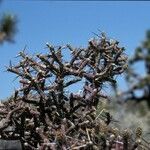Trees or shrubs, intricately branched, 0.5-2 m. Stem segments firmly attached, green drying gray and ropelike, cylindric, 2-8(-10) × 0.4-1 cm; tubercles rhombic, convex (flattened upon drying), 0.4-0.8 cm; areoles subcircular abaxially, adaxially becoming usually deltate-linear; glochid-bearing portion protruding distally, wedged between bases of 2 adjacent tubercles, (3-)4-7 × 1-1.5(-2) mm; wool tan to white. Spines 0-5 per areole, usually in distal areoles or sometimes absent or nearly so, tan to red-brown to deep purple, aging gray; major abaxial spines 0-1(-2), the longest spine spreading, (1.5-)2.5-6 cm; adaxial spines usually reflexed, short to ± 1 cm; sheaths baggy. Glochids in subcircular to linear adaxial tuft, yellow to tan to brown, to 2 mm. Flowers: inner tepals bronze-red ± suffused rose, with mid stripes darker, ovate, 6-13 mm, acute-apiculate to attenuate; filaments greenish; anthers yellow; style whitish or blushed with rose-pink or light green; stigma lobes whitish. Fruits maturing tan, ellipsoid to stipitate-ellipsoid, 15-30 × 10-15 mm, dry at maturity, tuberculate, developing increasingly burlike, with many bristlelike spines; areoles (32-)40-66, evenly spaced, woolly. Seeds pale yellow to tan-gray, angular to squarish in outline, warped, 4-4.5 × 3.5-4 mm, sides irregularly concave-convex; girdle smooth. 2n = 22, 44.
More
A bushy cactus. It grows about 60 cm high. The joints are greyish-green. They are slender and 5-10 cm long. They spread to form dense spiny clumps. The joints are 5-6 mm thick. They have a woody core. There is usually only one spine per 5 cm and this quickly falls off. The flowers are 4 cm long by 1-2 cm wide. They are greenish yellow.
Dry situations in creosote bush scrub and joshua tree woodland. Mojave and Sonoran deserts, washes, flats, and bajadas, growing on sandy loam, desert pavement and stony volcanic substrates; at elevations from 50-1,100 metres.
More
It needs full sunlight. It needs a temperature above 10°C.


